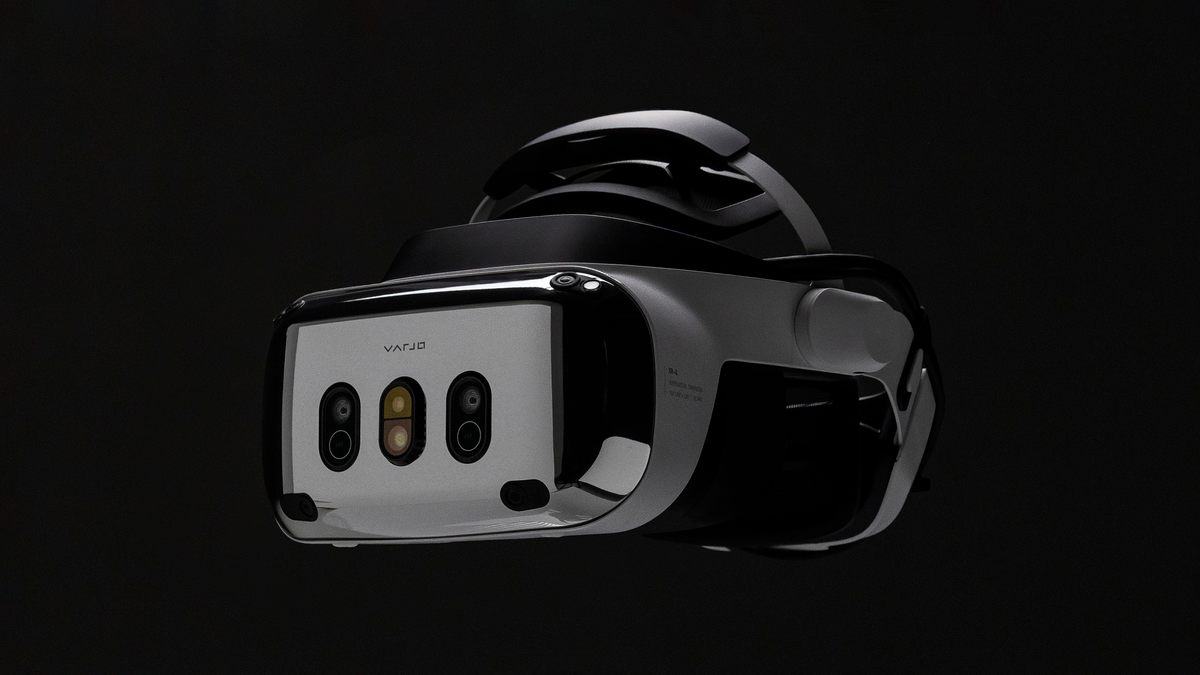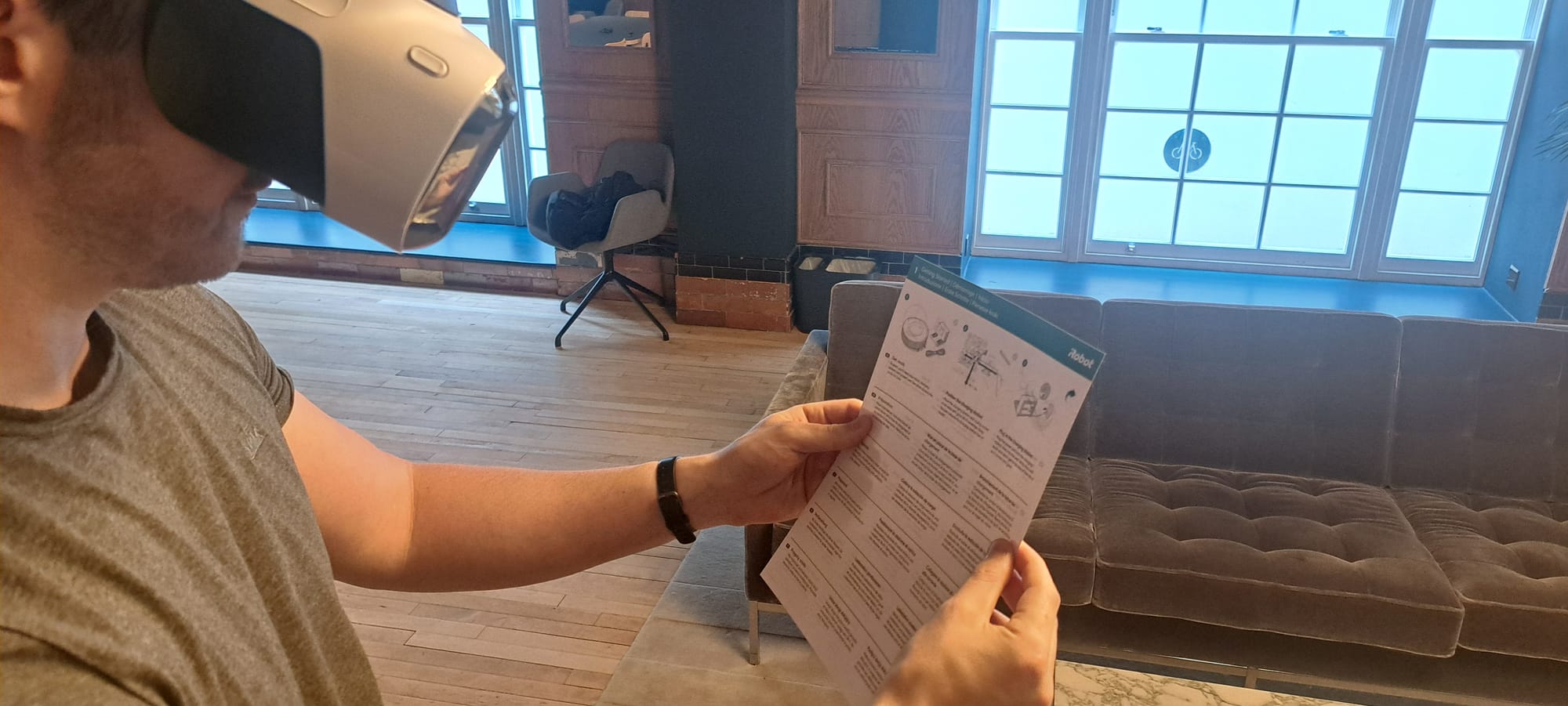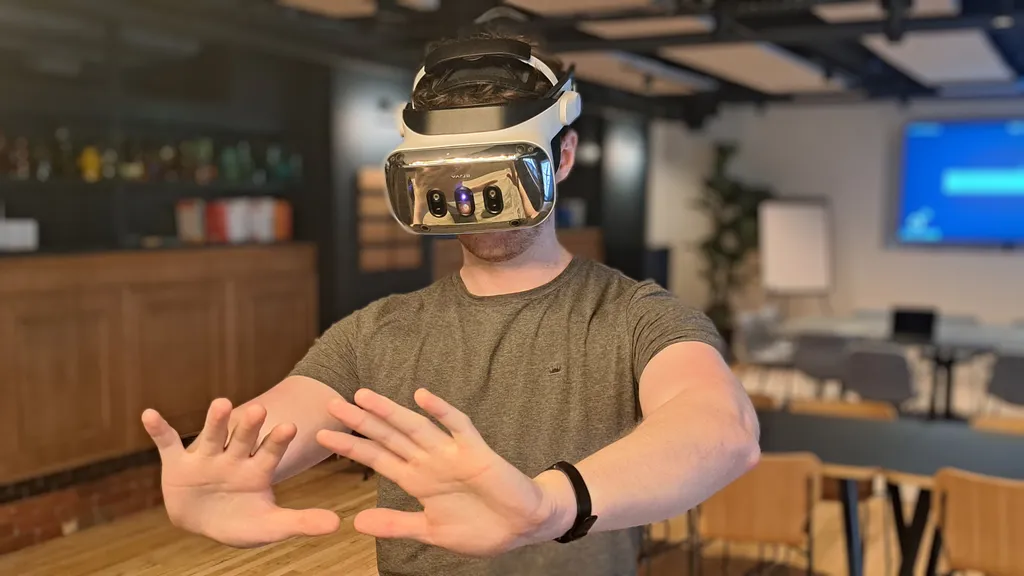I recently went hands-on with Varjo XR-4 Focal Edition, the $9990 headset the company claims provides VR and MR “indistinguishable from natural sight”. But does this claim really hold up?

Comfort & Cable
At over 1 kilogram Varjo XR-4 is on paper an extremely heavy headset, but you wouldn’t know that when wearing it. It features a hybrid halo strap design which puts most of the weight on your forehead while also having thick top and rear padding. The result is a headset that didn’t feel uncomfortable at any time in my roughly 45-minute demo.
The ability to adjust the eye relief also means Varjo XR-4 should easily accommodate glasses, though I don't wear glasses, so I didn't test this myself.
The disadvantage of this design is that the headset always felt a little too loose on my face, no matter how I adjusted it. This would make it deeply unsuitable for active gaming, but this isn’t a headset designed for that. It’s mostly designed for visualizing realistic 3D models and environments, as well as for training tasks such as flight simulators.
While it isn't wireless, Varjo XR-4 uses a fiber-optic cable the company tells me is by itself more expensive than a Meta Quest 3. Not only does this make it thinner and lighter than the cable you’d find attached to headsets like Valve Index, PlayStation VR2 and Bigscreen Beyond, it also means it can theoretically be extended to very long distances without the need for the clunk of active repeaters.
Lenses, Displays, And VR Quality
Unlike its predecessors, Varjo XR-4 has one 4K LCD display per eye, without separate micro-OLED focal displays, yet it still promises near-retinal display resolution in the center of your field of view. How? Because it uses large aspheric lenses with a highly variable magnification to prioritize pixel density in the middle while stretching out relatively fewer pixels across the periphery.
| Varjo XR-3 | Varjo XR-4 Series | |
| Displays (per eye) |
1920×1920 for central 27°×27° (70PPD) + 2880×2880 background (30PPD peak) |
3840×3744 (51PPD peak) |
| Refresh Rate | 90Hz | 90Hz |
| Field of View | 115°×78° | 120°×105° |
| Local Dimming | ❌ | ✅ |
| Brightness | 100 nits | 200 nits |
| Color Gamut | 93% DCI-P3 | 96% DCI-P3 |
I say "near" retinal here because Varjo XR-4's display system achieves 51 pixels per degree (PPD), slightly shy of the 60 PPD threshold generally accepted to be what the human eye can discern. It's also slightly less than the 55 PPD of Meta's Butterscotch prototype which I tried last year.
Those minor caveats aside, 51 PPD is still far beyond any other headset you can buy - for any amount of money. Combined with a realistic virtual scene rendered by the power of a high-end PC, the result is visual quality nothing short of stunning. In a virtual car for example I could make out the smallest details in the dashboard at the same distance I could in reality.
And it's not just the resolution that's impressive here. Like Somnium VR1, Varjo XR-4 provides around 200 nits to the eye, around double what Quest 3 and Apple Vision Pro can do. And since humans perceive brightness logarithmically, this feels more than twice as bright. This makes the sun and sky of a virtual world feel much more like really being outdoors. And combined with local dimming, the contrast and black levels feel much better than regular LCD, though still not quite at OLED level.
The only disappointing aspect of Varjo XR-4's VR image is the practical field of view. On paper it's 120°×105° yes, wider and taller than most headsets on the market. But in reality I saw both distortion and brightness inconsistencies in the periphery. To avoid these distractions, I adjusted the eye relief to reduce the field of view, to the point it was roughly on par with a Quest 2.
Passthrough Mixed Reality
In both Meta Quest 3 and Apple Vision Pro it's jarring to see how much lower quality the real-world passthrough view is than virtual objects. While interfaces and enemies are sharp and crisp, the passthrough is often grainy, blurry, and lower contrast.
Varjo XR-4 was supposed to buck this trend thanks to 20-megapixel passthrough cameras, compared to 4MP on Quest 3 and 6.5MP on Vision Pro. The Focal Edition I tried even has autofocus guided by eye tracking. When announcing the headset Varjo claimed this would give it passthrough quality "practically indistinguishable from natural sight".
In practice, this is not what I saw at all. In fact, Varjo XR-4’s passthrough quality, despite its on-paper specs, felt overall worse than Apple Vision Pro.

To start, the depth and scale were very off in the near-field, to the point I would feel sick if I was walking around in passthrough due to the overall geometric distortion. Unlike Meta and Apple, Varjo doesn't seem to be doing any kind of correction for depth at all.
As I mentioned earlier though, this is a headset designed primarily for sitting. But even ignoring the depth scale, the detail and clarity just wasn't impressive, even in the autofocus region that adds $6000 to the cost (the base model, without autofocus, is priced at $3990).
I should note that the lighting conditions in my demo room were far from ideal. I wouldn't call it dim, but it wasn't bright either. Still, the lighting was at least as good, if not better, than it was at my Somnium VR1 demo, and I found VR1's passthrough to be better than Varjo XR-4 Focal Edition, despite being around a quarter of the price.
When it comes to occlusion, Varjo XR-4 uses its LiDAR for dynamic occlusion, and developers can easily integrate this with a few clicks. It works well and provides an occlusion quality slightly better than Quest 3 - with one exception. The headset's LiDAR can't see black objects, because they fully absorb the light. To solve this, Varjo would need to use computer vision instead.
The Challenge Of Passthrough
You may be wondering how I can be saying all this about a headset with 20 megapixel cameras. On paper, it should be trouncing its competitors. But there are two reasons it doesn't.
First, resolution is only one metric of a camera. What arguably matters more is the aperture and sensor size, which determine how much light comes into and is captured by the camera. Somnium VR1's trick is to use a larger aperture and sensor size, and despite its price, Varjo XR-4's cameras are still quite small.
But the bigger problem is bandwidth, the key limiting factor on all passthrough mixed reality systems today. Transmitting millions of pixels at a high frame rate is a challenge for even the latest USB standard, and processing them is even harder. Dual 20-megapixel cameras, for example, is equivalent to five 4K video streams. And that's why Varjo doesn't even try. In reality, what you see is a lot lower resolution.
Vrgineers, the company behind XTAL headsets, is working on a solution for this problem that involves a custom chip in the headset combined with a custom PCI-E card that slots into a PC. The headset and card are likely to cost even more than Varjo XR-4, though, but this may be what it takes to actually deliver on the kind of passthrough Varjo promised.
Conclusion
All things considered, Varjo XR-4 provided the highest quality VR image I've ever seen, approaching complete realism in virtual details. But it doesn't push forward field of view, at least not without unacceptable tradeoffs. And its passthrough is nothing better than what you'd get on a Quest 3 or Apple Vision Pro, and in some ways markedly worse.
Varjo plans to sell XR-4 to wealthy consumers starting later this year. But the gulf between the VR quality and passthrough is so great that I think Varjo should sell a "VR-4" without passthrough, focusing on the headset's strength as a VR headset without adding cost to support its weakness as a mixed reality device.































